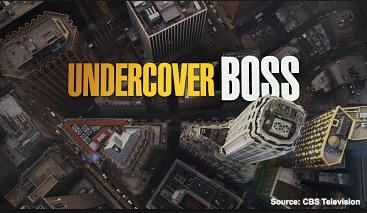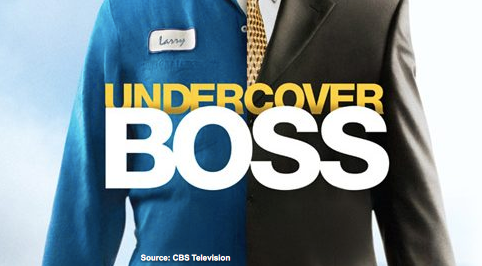Funny as it sounds binge TV watching can help you be a better leader. Undercover Boss provides an instructive look behind the scenes of real companies. There are lessons you can take without having to go undercover! Tune in.
Finally! A connection between binge-watching and something constructive professionally like becoming a better leader.
I’d heard of the show Undercover Boss but never watched it. Recently I found myself pulled in by an episode featuring the CEO of a large client of my former company. I watched it. As a result, I then watched the three that followed and since then more than I’m willing to admit.
The show provides a senior executive a frontline look at their organization. The key is the secret nature of it. CEOs see their organization exposed – warts through to heroism. The learnings are dramatic in some cases. Finally, the experience is often emotional and in all instances impactful for the executives.
Could you pull off something similar in your world? What would you learn about your business and your leadership if you were “undercover”?
I get it; you aren’t likely to be undercover anytime soon. So, how can you tap into these same learnings absent going undercover?

A Quick Set Up On The Show
The series originated in the United Kingdom and extended around the world. There are over 60 episodes in the US featuring CEOs and other executives from a who’s who of companies. CBS describes the show:
UNDERCOVER BOSS is a two-time Emmy Award-winning reality series that follows high-level executives as they slip anonymously into the rank-and-file of their own organizations. Each week, a different leader will sacrifice the comfort of their corner office for an undercover mission to examine the inner workings of their operation.
Yes, there are unpleasant things exposed, but overwhelmingly it’s filled with valuable observations and insights.
Two Side Notes – One Silly, One Not:
1. You can’t help but notice several of the worst hair dye jobs ever (e.g., the CEOs during their undercover status).
2. Critics of the show take issue with the generous financial contributions offered by the CEOs to individual employees they encounter. The CEOs shouldn’t put forth the company’s money, so the criticism goes.
While I get that critique, I don’t know how you get close to people’s everyday struggles, have some power and money to help and don’t. It would indeed alter the appeal of the show. Above all, it would reveal an executive that employees likely wouldn’t follow.
These criticisms aside, for viewers there is a kind of leadership “lab” playing out on the screen that supports the cause of becoming a better leader. It seems like there is more benefit from harvesting the lessons rather than looking for its imperfections.

What The Bosses Get To See
A stretch of time on the front line of an organization allows the execs to see, experience and engage in:
- How work gets done (or not)
- How their product or service goes to market
- Interactions with customers
- Working conditions & operating environment
- Onboarding and the job training
- Quality and commitment of front-line employees
- Quality and commitment to front-line management
Shhh. Becoming A Better Leader Starts With Listening
While the takeaways for the execs are quite specific to the individual company they fall into nine general categories:
- The good, the bad and any ugly on how work gets done.
- How “good ideas” from corporate translate in the field. This part is fascinating (as you might guess)! Spoiler alert, the good ideas don’t all translate. Shocking I know.
- People observations – strengths, flaws, struggles. It puts an individual face on what the organization puts into the marketplace and the real-life story behind each person doing it.
- Values of the organization – if and how they present daily.
- Power of listening and engagement. Front-line employees and managers are rarely engaged enough by the companies. There is sincere gratitude for being genuinely heard.
- More in-depth understanding of the organization to shape decision making on things like how to move strategy to execution, communication, training, front leadership, and incentives.
- Realization of what and how much the execs don’t know about their organization. A sense of disconnect comes through loud and clear.
- Need and intention to connect consistently with front-line employees.
- Humility and gratitude for the people who work on behalf of the organization they lead.
The weight of the impact the CEOs feel comes from the realization of how employees genuinely care about the organization. And how the employees “are” the business – they are the interface with customers, suppliers.
Employees real-life struggles are revealed. They deal with them – some crumble, some conquer, but they go to work and get the job done for the organization.
It isn’t always pretty either. Leadership gaps evidence. Managers don’t have the right training or resources. Or it evidences managers who don’t fit the culture.

We’re From Corporate. We Have A Great Idea
One of the common problems revealed is what happens when good ideas developed at the corporate level translate into the business. For example, one episode showed how construction employees get paid more based on achieving a higher number of installations. The incentives were designed to drive higher productivity. However, the senior crew member revealed to the CEO that no one has ever nor will ever hit the target because it is too high. The employee explained how frustrating it was for him and his crew.
The CEO had no idea the program wasn’t working and was hurting morale. He explained how useful the concept seemed when generated in the corporate office. And then admitted frustration that it was so unrealistic.
Related: Being open to learnings is a critical part of this process of getting in touch with your people. Read Why The Best Leaders Empty Their Cup First.
Most people don't care who's in charge as long as someone is. – Tanya Huff
— Gordon Tredgold (@GordonTredgold) March 12, 2018
No Hair & Makeup Needed To Insert Yourself Into Your Organization
You can’t and don’t need to create Undercover Boss inside your organization to become a better leader. You can deepen your understanding and empathy for the front face of your organization.
When was the last time you were in the field with a crew, manned the phone at a call center desk, worked on “the floor,” did a ride along or lived an operating process from A-Z? Every organization has a front line. The question is if and how often you engage with yours.
As you engage, a few simple guidelines that mimic the Undercover Boss approach. They will serve your efforts to become a better leader:
- Wear what they wear or close to it.
- Don’t observe, do the work
- Be curious, ask questions
- Get to know the people – on breaks, meals, etc.
- Be clear on what you learned and what you will do
- Say thank you for their contributions and the learnings
Spending more time with your people yields benefits. The insights about the work environment, culture, management, communication and decision making are invaluable.
Fundamentally it is about bridging the distance from your desk to the front line.
For your people, there is no more precise way to reinforce their contributions matter than to spend time, alongside them. People will talk about the day you spent with them for a long, long, time!
QUESTION:
How do you stay in touch with what goes on in your business?
Please know that sharing your comments below & across this audience matters. A robust conversation to benefit all can and will break out! Thank you in advance for sharing and engaging.
Tools For You
If you are interested in dipping your toe into the Undercover Boss world, start with Season 3 Episode 13. I challenge you not to choke up. Watch it alone just in case!
For a printable PDF of this post, click here.

